SAP CRM Software Review
SAP CRM Software Independent System Review
SAP Introduction
Founded in 1972 (as Systems Applications and Products in Data Processing) in Walldorf, Germany, SAP has become the world's largest business software applications company. The company's ERP (enterprise resource planning) application is used to integrate enterprise-wide back office operational functions such as accounting, distribution, supply chain, human resources/payroll, manufacturing and customer relationship management (CRM). SAP touts more than 36,500 enterprise customers in over 120 countries.
SAP isn't known for deployment of individual line of business applications such as CRM software, accounting software or distribution software. However, SAP has become infamous for fully integrated enterprise-wide ERP systems deployment, that is, being the central ERP system for all line of business applications across the enterprise. With such a grand application software scope, SAP implementations are not for the faint of heart. As well stated in an AMR Research report authored by analyst Jim Shepherd, " ... this is typically a multiyear, multimillion-dollar effort to transform the business."
SAP ERP Software Evolution
For most of its corporate history, SAP was the manufacturer of a single ERP software solution originally named R/1, then R/2 and finally R/3. However, in 1999 the company branched its flagship ERP software to include dozens of new, ancillary and derivative software solutions. The company now has three traditional (on premise) ERP software systems (Business Suite (aka SAP ERP), Business One and Business All-in-One) and one announced but yet to be delivered software as a service (SaaS) ERP system (Business ByDesign). SAP has also created or acquired several non-ERP software products in the areas of compliance management, performance management and business intelligence (BI).
The SAP Business Suite (often just called SAP ERP or mySAP ERP) stands alone as the flagship product that derives nearly all company revenue. Business Suite includes the primary enterprise software components of ERP, CRM, product life cycle management and other related business software components. Business Suite has a maintenance cycle until 2013. It remains unclear whether SAP plans to continue Business Suite beyond that date or introduce a product replacement.
SAP Technology
SAP's current technology play emerged in 2003 as a platform stack based on NetWeaver. NetWeaver is the development platform for its ERP product line, created on a service oriented architecture (SOA), consolidates a number of formerly disparate technology components, and along with SAP Web services is the technology tool to be used to customize, integrate, append or otherwise modify SAP applications. While NetWeaver is a powerful software technology tool, its proprietary nature often doesn't sit well with IT departments already well versed on industry standard technologies such as Java/J2EE or .NET and not wanting to acquire, train and evolve additional IT resources to support yet another proprietary vendor technology. However, for SAP customers, NetWeaver is an inherited cost of the ERP business application. As well put by analyst Shepherd of AMR Research, "The reality is that SAP customers have to use NetWeaver because their applications won't run without it, and over time, they tend to begin to use the optional components, such as business intelligence, the portal, and integration."
SAP Strategies
SAP's growth strategy is a combination of customer share growth, vertical market expansion and entry to the sky rocketing software as a service industry.
The ERP software giant exercises a customer wallet share growth strategy whereby the company seeks to increase existing customer revenue by licensing 75 percent or more of each customer's total staff. SAP also continuously pushes ERP customers to acquire new and continuously expanding supporting software tools such as Microsoft Office integration or business intelligence decision making utilities. According to AMR's Shepherd, "The strategy is to create capabilities that either encourage additional user seats within the existing products or require licensing brand-new products outside the Business Suite." Unfortunately, this constant up-sell and cross-sell strategy is often misaligned with customer expectations. SAP customers generally expect to make large up front financial investments, however, also expect upgrades and enhancements at no additional charge beyond the annual maintenance payments. Nonetheless, SAP like many other software publishers shows a pattern of introducing new capabilities, functions or software modules as brand new products requiring further capital expenditures. Shepherd comments, "Like most established software vendors, SAP derives most of its revenue from the installed base. Its object is to ensure that customers never stop buying licenses, maintenance and servers."
SAP has succeeded in dominating vertical markets such as wholesale distribution, electronics distribution, oil and gas, chemicals and life sciences. Now SAP is investing R&D efforts to accommodate the unique business software requirements for several non-manufacturing industries such as professional services, government and public sector, retail, financial services, education and banking. Expect SAP to lock horns with rival Oracle for customer acquisition in many of the same vertical markets.
SAP Challenges
SAP's four most pressing challenges are integrating a massive Business Objects company acquisition, getting customers to upgrade, competing in the CRM software market and showing some success in the software as a service ERP arena.
While SAP makes occasional strategic acquisitions, it doesn't follow the acquisition frenzy strategy of competitor Oracle. However, it also hasn't shown the post-acquisition integration successes as has Oracle. Taking a lesson learned from the SAP acquisition of TomorrowNow which has been a complete debacle and reputational blemish, SAP needs to invoke more control, but not too much control, into acquired companies. The integration of Business Objects is a monumental task. SAP needs to balance the right amount of corporate governance and refrain from the desire to revamp Business Objects architecture with SAP's NetWeaver.
It's a problem when only about 6,000 of 34,000 SAP customers have upgraded to the most current SAP ERP 6.0 product which was released almost two years ago. Historically, SAP has introduced an upgraded ERP software product line about every five years and material point releases or new version releases about every 6 to 13 months. While the company has evolved its product evolution from the big bang complete replacement upgrades to more of a continuous process, which it calls its "continuous innovation strategy", new releases are nonetheless often fork lift upgrades and continue to impose great caution for customer's deciding whether to upgrade. While the iterative approach to SAP upgrades is welcomed by most, it has resulted in the majority of SAP customers deferring upgrades for extended periods. Most and the majority are more than one release behind.
While SAP claims to be the CRM software solution market leader, that claim is seriously challenged by Oracle and a slew of analyst firms. SAP knows it must advance its CRM software solution in order to take on Oracle's Siebel CRM solution as well as its new Oracle Fusion CRM software. Expect SAP to use its back-office ERP strength in an effort to gain traction in the CRM software market. See the SAP CRM review to better understand how SAP is leveraging cloud ERP and CRM software to capitalize on the SaaS movement.
SAP has struggled to develop and release a software as a service ERP system. After a media blitz in September 2007 in which SAP officially announced the Business ByDesign SaaS ERP system along with several lofty growth claims, the company later retracted most of its plans in May 2008 and then acknowledged that technical problems had delayed the product release (by at least 12 months) and the company had cut staff working on the project, dramatically cut the R&D budget for the project and lowered its on-demand customer acquisition forecast.
SAP's setbacks are exacerbated as they become fodder for on-demand competitor Salesforce.com. In one of many provocative moves Marc Benioff, CEO of Salesforce.com, released an email to Salesforce.com employees but most certainly intended to be forwarded to close media sources, stating, "While SAP claims leadership in CRM, experience suggests a different story... if SAP's CRM software is any good, then why don't they use it to manage their own customer relationships? ... I have interviewed hundreds of salespeople and executives from SAP from around the world, and each has told me the only CRM system at SAP is an executive system based on Microsoft Excel." The Salesforce.com CEO went on to list numerous SAP big customers such as DuPont, DeutschePost, AirProducts, Autodesk, EFI, DeutscheBank, Analog Devices, as Salesforce.com CRM customers. Of course with Salesforce.com's CEO, all comments must be taken with a grain of salt. After all, this is the same CEO that used a media mouthpiece to mock an entire country with a demeaning German accent and ramblings to describe SAP's procrastination into the software as a service CRM market by stating, "Vell! At SAP, let me tell you, softVARE as service is just one way to deliver softVARE!" Benioff blusters. "It's just a del-i-ver-y met-o-do-lo-gy! Customers vant hosted--and zen zay moove!"
Nonetheless, while a bit inflammatory, Benioff's comments mark several valid points. In fact in one face to face exchange in April 2008, Benioff's antagonistic comments to SAP Co-founder and Chairman Hasso Plattner resulted in Plattner admitting deficiency in the CRM software market by stating "." SAP's delivery of a respectable SaaS ERP solution before the end of 2010 is needed if SAP intends to effectively compete in the on-demand ERP market.
![]()
3999 West Chester Pike
Newtown Square, PA 19073
Telephone: (800) 872-1727
Email: [email protected]
Web:
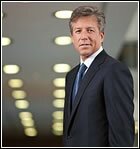
Bill McDermott, Co-CEO
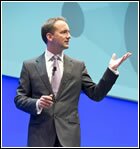
Jim Hagemann Snabe, Co-CEO
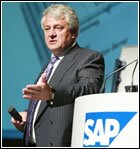
Hasso Plattner, Chairman
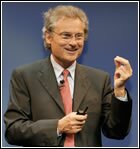
Henning Kagermann
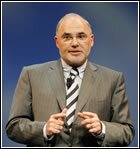
Léo Apotheke, Former CEO
Henning Kagermann was SAP AG CEO since May 2003 and Co-CEO since April 2008 along with Léo Apotheker.
Kagermann started with SAP in 1982 in the product development areas of cost accounting and controlling. He later directed the development of all administrative software solutions, including human resources and vertical market development for financial services, healthcare and government and public sector. His responsibilities also included finance and administration and the management of all SAP global regions. Kagermann has been on the SAP Executive Board since 1991. Together with Hasso Plattner, co-founder of SAP, he was co-CEO from 1998 to 2003, and became sole CEO when Plattner moved to the supervisory board in May 2003. Kagermann sponsored the supervisory board to nominate Léo Apotheker as co-CEO in April 2008.
Léo Apotheker served as co-chief executive officer of SAP from April 2008 until he resigned in February 2010, following a decision by the company to not renew his contract.
![]()
Other SAP Software Reviews
![]()
